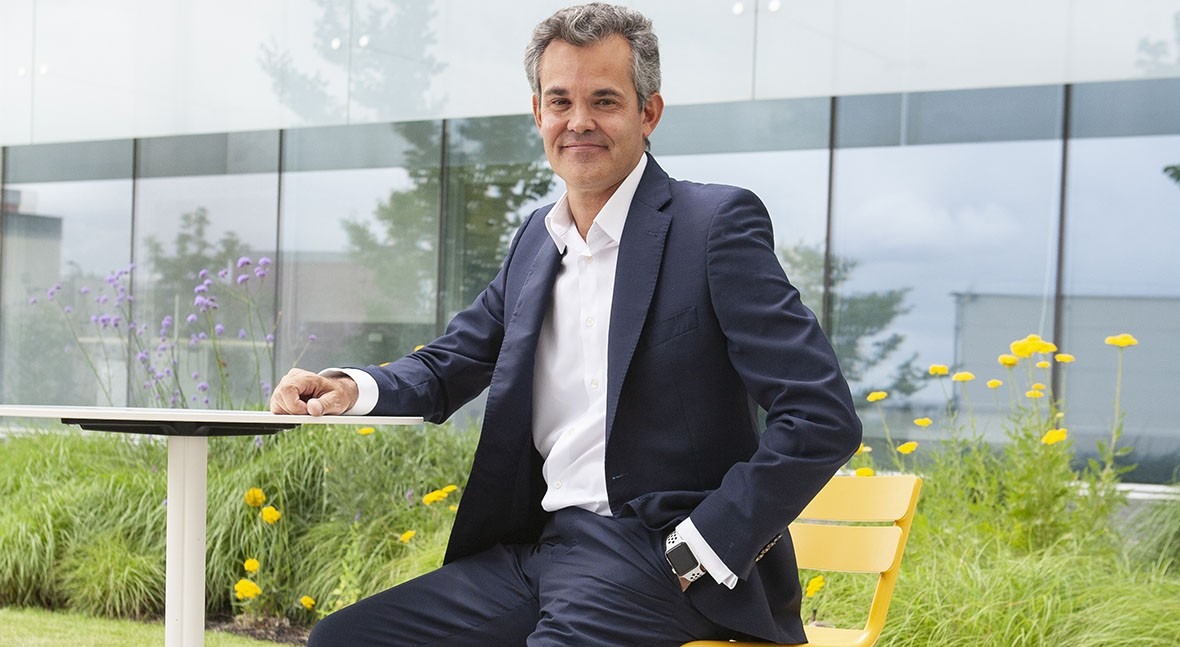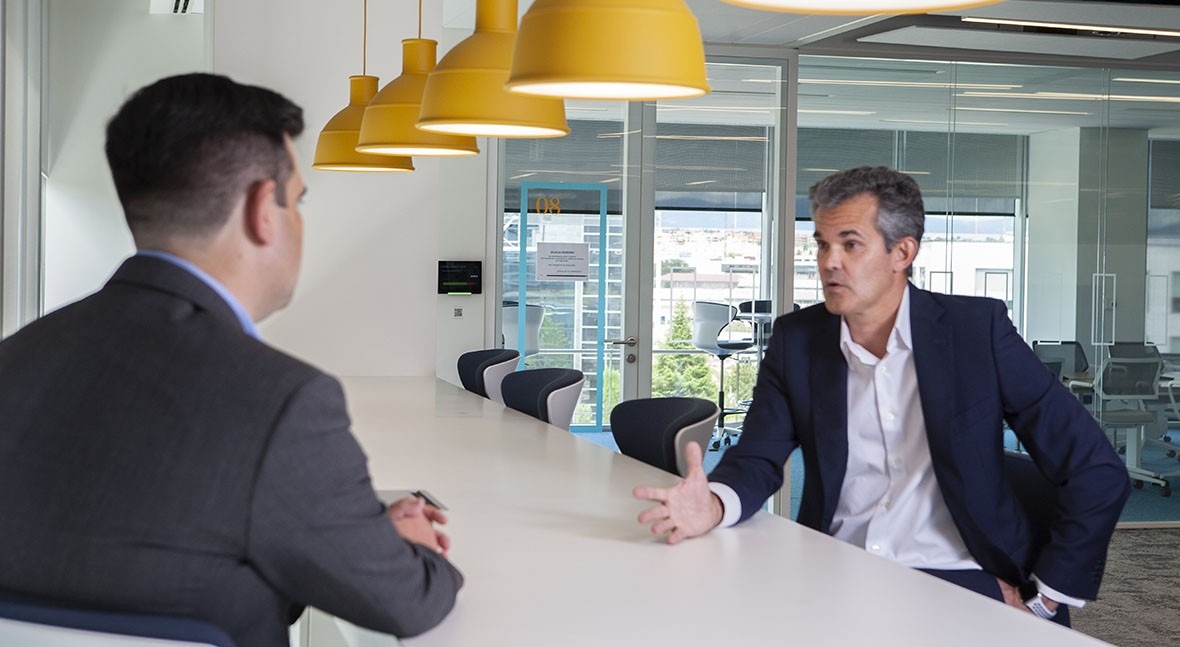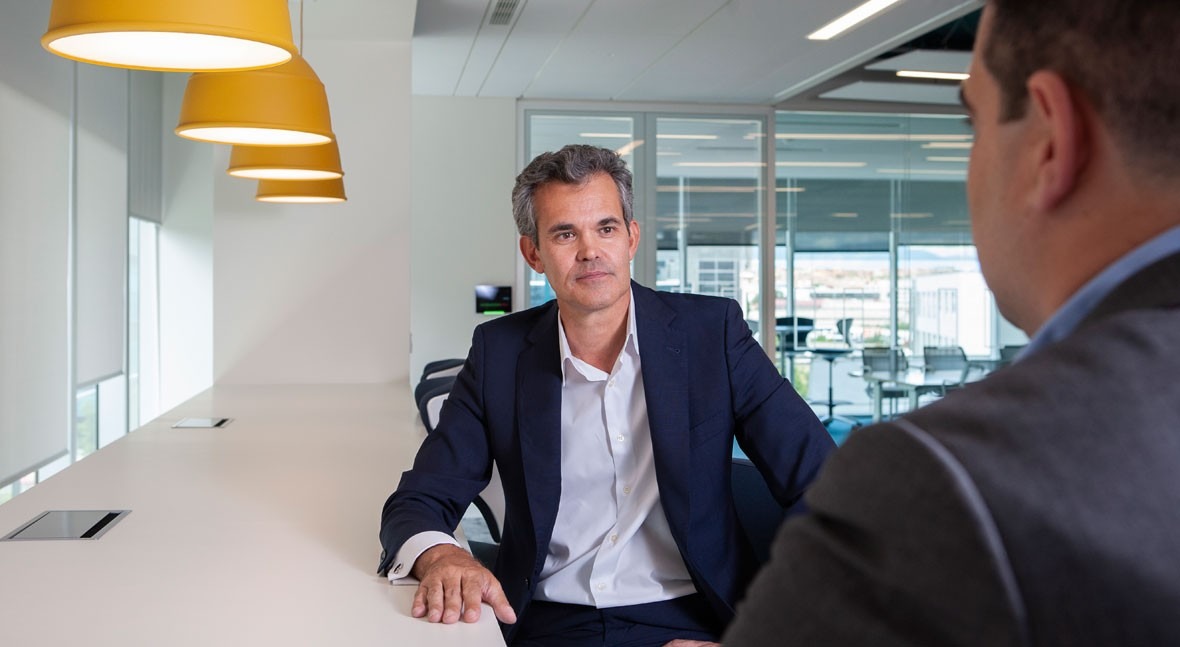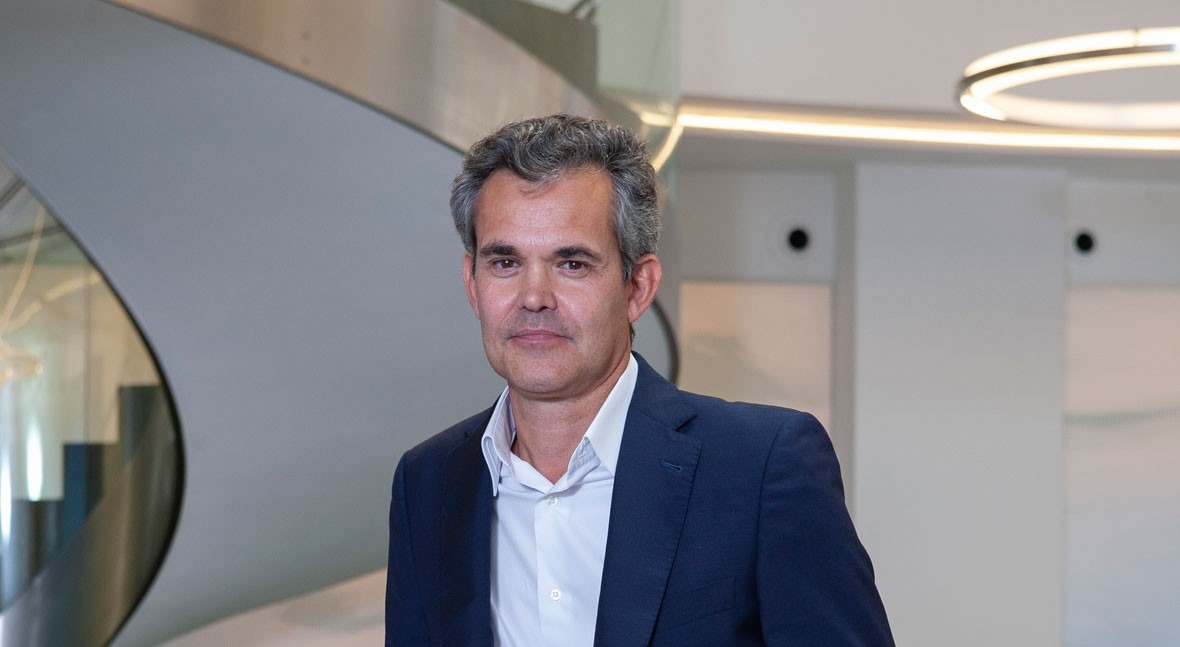“Phygital means leading an ecosystem of partners driving innovation and development in the sector”

Digitalization is an undeniable fact in our lives. The digital transformation has reached cruising speed and is changing the way in which, among other things, we manage water resources. This unstoppable trend has fortunately brought new players to the water sector who, years ago, played a minor role but are now leading players. Minsait is one of the most obvious examples.
Indra, one of the most internationally recognized Spanish multinational companies, encompassing multiple strategic sectors, has a growing presence with Minsait. Its activity in the water sector has grown exponentially in recent years. Now, with Phygital, it takes a step forward in the company's commitment to the integrated management of all the company’s expertise in the physical world.
Antonio Ibáñez is a technology enthusiast who, in a meteoric career dedicated to the digital transformation of utility companies, has been leading Minsait's global water segment for the last three years. Ibáñez welcomes us to Minsait's office at a time when the digital transformation has reached breakneck speed and more than ever needs professionals with clear ideas and a passion for what they do. Professionals like him.
Could you tell us about your career path and how did you come into the world of water?
I am passionate about technology, it’s my calling; since I was twelve years old, when I started programming with a ZX Spectrum, I was sure that my life would be linked to the digital world and all decisions in my career have been in that line.
Eleven years ago, I joined the Energy&Utilities practice at Indra, now Minsait, the company that brings together Indra's digital transformation and information technology businesses, where I started as a project manager for Aqualia. Three years ago, I was fortunate to be able to start managing the global water market.
In this last period, together with my team, we have put a lot of energy into consolidating existing water-specific products and adding new ones to the portfolio. Last year we pushed our Onesait Smart Metering product very hard and we are currently very focused on new products for water quality management in river basins, smart irrigation management and operational efficiency in wastewater treatment plants.
And can you tell us about your current role?
Well, I continue to enjoy the world of water more and more every day, and now the novelty is that I am doing so within a new division of Minsait called Phygital as the Director of Sustainability, a position from which, in addition to heading the water practice, I am also involved in energy efficiency, business sustainability and circular economy practices. I am very excited to be able to expand the scope of my work in something as important as sustainability. We are growing and consolidating a very powerful offer in this field, which I hope our clients will like very much.
You mentioned Phygital. What does it mean for Minsait?
For us at Minsait, Phygital is a great commitment to the future with which we seek to manage in an integrated manner the company's know-how of the physical world, meaning all types of sensors and equipment capable of sending or receiving data, the Internet of things (IoT) or Industrial IoT, and the digital world, where we need to use intelligence, with digital platforms and tools, to turn hundreds of thousands of signals and data into insights. The goal is always to have end-to-end projects, ranging from the identification of a business opportunity or improvement, to its implementation and subsequent support and maintenance. We seek solutions that add value to our clients and that are ground-breaking and sustainable.
Phygital is a commitment to the future: we seek to manage in an integrated manner the company's know-how of the physical world
Phygital also means leading an ecosystem of partners that drives innovation and development in the sector. These partners can be equipment manufacturers, owners of niche digital solutions or hyperscalers with cloud platforms such as Google, Amazon or Microsoft. In addition, they support us in the implementation of certain niche technologies or in certain geographies, and may even be regular competitors with whom we can work together to provide better solutions.
The digital transformation of the water sector is here to stay. What is the state of the art at the moment?
It is a sector with very different degrees of maturity. The first differences are geographical; we are a global company that is in 140 countries and we are doing projects simultaneously in different continents. Right now, in the water market, for example, we are carrying out projects in Gambia, Bahrain, the Philippines, Peru, Spain, Italy, Brazil, Mexico, among other countries. In each geography, the projects deal with very different themes, and this indicates a very different degree of maturity within the same sector. In Africa, we carry out projects dealing with core processes, where we provide a whole country with tools to manage customers as well as the network. On the other hand, in Brazil or the United States, we are already at a completely different level of maturity; here we are more focused on smart metering, leak detection using radar images obtained through remote sensing, or big data platforms for operational intelligence of infrastructure.
There is still a lot to do; it is important to have a structured vision and a solid digital strategy to plan activities
It is important to have a structured vision and a solid digital strategy to plan activities; technology should not be implemented only according to the latest market fad or putting out fires because decisions to upgrade were not made on time. There is a lot to talk about concerning how to approach a digitalization plan nowadays and the tools to choose from.
What are the biggest challenges of this transformation for water utilities?
I'm sure I'm leaving some out, but the main lines of work we see are as follows:
- Non-revenue water, either through commercial losses or physical losses. New commercial systems are needed to integrate the commercial cycle with network management and use advanced analytics to detect anomalous situations, fraud and losses.
Digitalization makes it possible to reduce operating costs and optimize company’s processes, making it more competitive
- Energy efficiency in plants and facilities, with state-of-the-art devices that enable savings in plant operations, rely on data monitoring and intelligence, and facilitate the detection of usage patterns and anomalous operating situations in equipment. By acting on them, savings can be achieved in a simple way.
- Asset management and maintenance is another major challenge; assets must be fitted with sensors, monitored and automated to be able to take advantage of this information and have decision-making and improvement elements in the network.
- Quality and alert management issues, whether in watersheds or distribution networks, are a trend. There is a great demand for new control equipment to improve traditional sensors and, with new communication technologies, to improve the management of scarce water resources through the use of alarms and advanced analytics. This automation is also needed to help irrigation associations move towards smart irrigation systems.

Several companies work with integrated water cycle managers in the digital transformation process. What are the differentiating features of Minsait?
Minsait is not just consultancy services. There is the entire Indra hardware and electronic equipment manufacturing side, which serves as the basis for many projects. On the other hand, we have in the group, an engineering company like Prointec, the largest European cybersecurity company SIA, a telecontrol company like ACS, DIVE artificial intelligence or Paradigma, the digital company par excellence. There are few companies in the world that can offer the integrated offering that Indra and Minsait do.
Another key element is our talent and strategy to create our own products. Onesait is Minsait's product brand; Onesait Platform, Onesait Customers, Onesait Grid, Onesait Metering, Onesait Efficiency, are part of an extensive range of products for utilities, industry and financial services.
Is investing in digitalization cost-effective?
Digitalization makes it possible to reduce operating costs and optimize any company's processes, making it more competitive, something that becomes even more relevant in a crisis environment like the current one. I believe that managers who are not committed to digitalization and do not manage their digital transformation well are putting their company at a competitive disadvantage compared to those who do.
The technical architecture of systems is important: present and future are phygital and you cannot continue with classic architectures
And from an economic point of view, in times of crisis, it is also important to develop projects that have a clear return, that is the key. So, it seems simple, but how many useless projects are carried out or how many projects that were necessary never become productive because of poor execution and in particular because of poor change management? We must take care of all aspects, including training and communication in organizations; people are key.
As part of the digital transformation process, we are seeing the development and implementation of different technologies. Which ones are they, and which ones do you think are having the greatest impact?
I would start with the basics. Nowadays there is a lot of talk about the platform concept; I think that the technical architecture of the systems is very important, the present and the future are already phygital and you cannot continue with classic architectures; every day there is more equipment connected to the network, there are hundreds of thousands of signals sent, providing information that is difficult to process.
Concerning digitalization, the degree of digital maturity varies from one country to the next, but the challenges are the same
Today the intelligence of systems is distributed: there is equipment with intelligence in the network, in the Edge; these can make decisions autonomously and only send to the cloud the relevant information, which has to be collected very efficiently given its volume and then has to be stored in databases that are different from the traditional ones. They are more distributed to enable scaling; they must be able to store data and time series-data, and that leads to being able to process quickly that information.
In addition, these new architectures must facilitate and have processing tools using algorithms and be available through dashboards that users can create autonomously. There are platforms provided by hyperscalers (Google, Amazon or Microsoft) and there are open platforms such as the one we use at Minsait – Onesait Platform – where we are developing all our new products and vertical solutions and creating new versions of older ones.
On the other hand, there are technologies that are more focused on the physical part being applied in the water industry and which are quite diverse, from fiber optics to identify leaks in pipes with a certain flow rate, to radar images that make it possible to identify leaks up to ten meters belowground by measuring the dielectric constant of the ground, equipment that improves energy efficiency in plants, meters with increasingly durable batteries and ultrasonic leak detectors. The world of water quality sensors is evolving. At Minsait we seek to be a technology hub where we work with our partners to provide our customers with the most innovative technologies. I invite all partners with unique solutions to contact us to expand our ecosystem of solutions.

Non-Revenue Water is another of the major challenges faced by urban water cycle managers. What is Minsait's approach to tackling this problem?
Most companies in the water sector have integrated information technologies as a key element in their strategic plans and have made significant progress in the adoption of these technologies. However, the process of remote data acquisition is one of the critical processes of water utilities, which still has a long way to go.
In this area, the adoption of smart devices and smart meters, whose deployment has increased considerably in recent years, is the main enabler for the digitalization of data acquisition processes in the field.
The process of remote data acquisition is one of the critical processes of water utilities, which still has a long way to go
On the other hand, the information provided by a network of smart meters is a key element to quantify the volume of unaccounted-for water, as well as its causes (leaks, unauthorized consumption, metering errors, etc.) and their location.
However, the deployment of a network of smart meters and the large volume of information obtained from them is not valuable enough without the ability to manage and make use of this information. At Minsait we are aware of the importance of data management and, based on this premise, we have developed Onesait Metering, a solution capable of managing the information from the network of sensors and IoT devices deployed in the field.
Through the Onesait platform, Minsait integrates advanced tools that facilitate, among other things, the control of commercial and non-commercial losses in distribution networks. This platform is integrated with the Onesait Sensing solution for the detection of leaks and threats in real time. It includes an automatic system based on the use of DAS (Distributed Acoustic Sensor) technology that uses standard communications fiber optics and monitors transmission and distribution networks by transforming optical signals into alarms with a user-friendly and functional user interface.
Among all the solutions that Minsait has for the water industry, which one would you highlight as the most innovative?
The Oblysis technology is a revolutionary solution in the field of wastewater treatment. This solution improves plant operations, saving up to 40% of energy, reducing the volume of sludge by around 35%-40%, while also reducing the consumption of reagents and transforming the plants from active sludge to granular sludge. It is something unique and revolutionary that allows efficient operations while at the same time contributing to reducing the environmental impact, improving the quality of the discharge. We work together with operators, identifying the savings to be achieved, which are shared with them, therefore without the need for any investment on their part.

To conclude the interview, how would you like water to be managed in twenty years’ time?
I would like to see our efforts and those of our partners generating a real impact on our customers and that this is noticed: I would like to see an increasingly efficient and sustainable water industry thanks to us and what we do.
We hope that water will become more accessible to everyone, that it will reach citizens with ever-higher quality and that we will be able to make it drinkable again with little effort, through increasingly efficient distribution networks, without losses, and with modern and efficient wastewater treatment. The challenge in twenty years' time is for the planet to be sustainable, and efficient water management is key to achieving this.





